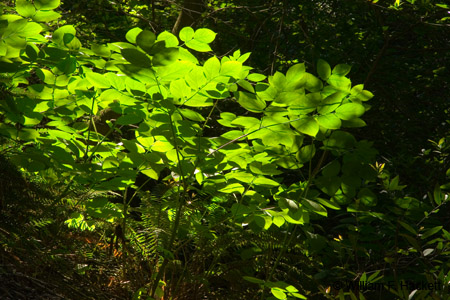Huckleberry Botanic Regional Preserve, part 2

I wrote about my first visit (part 1) to photograph at the Huckleberry Botanic Regional Preserve (abbreviated below as “Huckleberry”) last Saturday, June 14. This “ecological jewel” has a native plant community that is found nowhere else in the East Bay. I have since added some photos from the shoot to the earlier blog entry, and today’s blog entry will continue the description, with photos (now uploaded to Cheshire Cat Photo™) without repeating much information from the “part 1” entry.
Huckleberry features a 1.7-mile-loop self-guided nature path which traverses a wide variety of terrain and is maintained to minimum standards. As was the case with hiking in Wildcat Canyon, Huckleberry can be a cool, refreshing place to hike on a hot summer day. The path descends into a mature bay forest, follows the contour for half a mile, and then ascends into a upper layer that is botanically rich and diverse. If there are members in your party who need a less strenuous walk, remain on the upper trail, and you will still see most of the numbered stops of the self-guided tour.
Almost immediately, I was impressed with the ferns! The ferns were to be a companion through much of the trail. On the lower portion of the Huckleberry Path, there is a fork. As Yogi Berra said, “When you come to a fork in the road, TAKE it!”  in this case, a left will take you northwest on the Skyline Trail, and you want to take the right fork, up the hill, on the portion shared by the Huckleberry Path and the Skyline Trail. This may be a good time to stop and gain some perspective. Along the trail, there will be dark places and light places, places to stop and rest, another RIGHT fork, up the hill, and places to look back at the hill that you just climbed to the upper level of the trail! Some of the unexpected rewards of the upper portion of the trail included the tenacious manzanita, grand vistas (1, 2) of the East Bay hills and even views of Mount Diablo.
in this case, a left will take you northwest on the Skyline Trail, and you want to take the right fork, up the hill, on the portion shared by the Huckleberry Path and the Skyline Trail. This may be a good time to stop and gain some perspective. Along the trail, there will be dark places and light places, places to stop and rest, another RIGHT fork, up the hill, and places to look back at the hill that you just climbed to the upper level of the trail! Some of the unexpected rewards of the upper portion of the trail included the tenacious manzanita, grand vistas (1, 2) of the East Bay hills and even views of Mount Diablo.
I mentioned the rarity of the plant community in the earlier blog entry. There are also the rocks! The strata that are exposed in the preserve are from a deep ocean basin and contain the remains of microscopic diatoms and radiolaria, now uplifted and exposed as interbedded chert and shale (the Claremont shale/chert formation, probably exposed to erosion since the late Miocene Epoch of about 12 million years ago. These soils are very low in nutritional value and favoring pioneering plant species. Some of the pioneering species show swollen basal trunks, or “burls,” as an adaptation to fire. The soils of the barrens are well-drained at the surface, but the fractured rocks hold water for species with deep roots. Water comes from summer fog (the Preserve is directly across from the Golden Gate) and there is sufficient rainfall on the crest of the Berkeley Hills. Additionally, the northern exposure of Huckleberry protects plant species from too much sun. In the absence of fire, accumulated leaf litter can result in soils that are rich and deep. Live oaks and bay laurels have moved into these areas to shade out chamise and manzanita. This natural plant succession is part of the evolution of California’s landscape. Park literature states that Huckleberry has a year-round display of flowering species. One of these that we saw was Orange Bush Monkeyflower (hiding amid greenery) – a species that we had seen earlier in the year while shooting on Mount Diablo (1).
For a detailed description of the self-guided Huckleberry Path, pick up a brochure at the entrance or download detailed PDF files of the trail online (map side, text side). Other maps of the East Bay Regional Park District are here. Among the diverse plant species that you will see at Huckleberry (in “trail order”) are: Pacific Madrone (Arbutus menziesii), California Hazelnut (Corylus californica), Western Sword Fern (Polystichum munitum), Wood Fern (Dryopteris arguta), Manzanita, Douglas Iris (Iris douglasiana), Western Leatherwood (Dirca occidentalis), Jimbrush (Ceanothus sorediatus), Canyon Live Oak (Quercus chrysolepis), Coast Huckleberry (Vaccinium ovatum), Chinquapin (Castanopsis chrysophylla var. minor), Brittleleaf Manzanita (Arctostaphylos crustacea), Pallid Manzanita (Arctostaphylos pallida), Coast Silktassel (Garrya elliptica), and Pink-flowering Currant (Ribes glutinosum). The brochure also names other woody species in the Preserve.
I always like to leave something for “next time.” In the case of Huckleberry, these were the exposed barren knolls at map positions 6, 9, and 10. They might have wonderful views as well. If you travel there before I do, don’t spoil the surprise for me! 
-Bill at Cheshire Cat Photo™
You can view higher-resolution photos (*generally* 7-30 megabytes, compressed) at the Cheshire Cat Photo™ Pro Gallery on Shutterfly™, where you can also order prints and gifts decorated with the photos of your choice from the gallery. Apparel and other gifts decorated with some of our most popular photos can be ordered from the Cheshire Cat Photo™ Store on CafePress®. Both Shutterfly™ and CafePress® ship to most international locations worldwide!







